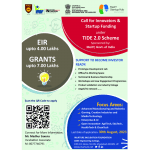
![]()
![]()
![]()
SIDBI x WaterBridge Ventures – Problem Statement Challenge

About
WaterBridge Ventures is a $150mn early stage VC fund that invests in pre-seed to pre-series A rounds with first ticket size of investment that lies between $300k to $3mn. Post the first check, we do follow on investments at pro-rata. We typically invest in 5-6 startups in a year. Some of the notable names in our portfolio include – Unacademy, Magicpin, CityMall, Chalo, Bijnis, Atlan, etc.
In the quest to empower entrepreneurial talent across the country, WaterBridge Ventures has partnered with SIDBI to help young entrepreneurs identify the right problem statements to solve for. The investment team at WaterBridge Ventures has curated a list of the most pressing problem statements in India’s consumer story and aims to support founders to build businesses around them. These founders will be required to furnish details about their existing startup and preliminary understanding of their potential business around the problem statements. On the basis of the above, the WaterBridge team will shortlist founders who will get a chance to seek mentorship from the WaterBridge investment team in order to strengthen their ideation process. Depending on the founders’ progress, WaterBridge team may decide to co-create the startup with the founder and explore funding them.
Problem Statements:
| S. No. | Problem Statement | Solution |
| 1 | Offline distribution of regional and D2C brands within the Electrical Goods and Consumer Electronics sectors is a major hurdle that prevents brands from scaling | Study business models of startups like Auzaarpay, Depo24, Material Depot, Mistry Store, Easebazaar, etc to come up with a Distribution as a Service startup that provides placement to these brands in retail stores, wholesalers, handyman, interior designers, architects etc |
| 2 | High default rates at retailers | Retailer underwriting on the basis of qualitative aspects like locality, size of shop, quality of brands stocked in the shop, rate of sales of products, no. of counters in the shop, local distributor feedback, no. of distributors catering the shop etc. Basically, evaluating these aspects which aren’t related to cash flow based underwriting done via Paytm, BharatPe etc is important so that retailers can be analyzed proactively rather than reactively after transactions. This new model can complement the quantitative mode of underwriting accomplished by existing startups. On the basis of the retailers underwritten, scores could be created that enable identification of retailers worthy of strong business |
| 3 | High churn in sales team with FMCG, Apparel, Electronics industry | Platform comprising of trained sales fleet and promoters in retail stores. These sales fleet and promoters cut across categories like electronics, BPC, Nutraceuticals, etc or across any category that has products with high AOV and the need to have greater customer awareness. The platform will source relevant sales fleet and promoters from tier 2 and beyond and train them. Basis the category that is doing well, this platform can start to approach other brands in that category and build its funnel of clients (brands) and can then place these brands in retail stores through their sales fleet and promoters. |
| 4 | Limited transparency of sales data for the brands across all industries. Existing datasets are reactive than proactive | Business Analytics platform enabling prescriptive analytics for sales, growth, data, and market researchers to research, collaborate, and drive growth. Study Nielsen and Kantar and their business models globally Reports are tailored to your needs that contain prescriptive and predictive analytics for multiple business-critical use cases like New product research and development New product variation research New geography and customer segment discovery and helping brands launch offline stores in certain micro-markets Competitor and acquisition signal Continuous pricing optimization Demand forecasting for new product launches These reports can be based on 4 types of data sources: Live public and social media data Brand’s own product, sales, and consumer data Human input Existing paid datasets and market research reports |
| 5 | Interpretation of sales data to build loyalty programs is tough for General Trade and Modern Trade retailers | MT & Standalone stores (with POS systems) chains don’t know how to interpret sales data to 1. build loyalty programs 2. provide discounts/trade schemes for certain items and introducing dynamic pricing for best-selling items 3. identifying less relevant categories that are slow moving 4. enhance sales team efficiency at store |
| 6 | Limited transparency over active distributors across India and how to evaluate partnership with them | Distributor underwriting to be evaluated on the basis of qualitative aspects like locality, turnover, partner brands, ROI, local retailer feedback, sales fleet feedback, etc. Subsequently, a SaaS solution can be provided to the brands to improve their sales across geographies |
| 7 | Govt. is finding it hard to onboard retailers to ONDC because of the highly fragmented nature of retail | Onboarding sellers to the ONDC network and digitizing them. Onboarding them onto the network is operationally complex and time consuming, however it may give the startups a strong idea of the problems faced by retailers in digitization. Some of these problems may serve as the foundation of new business models |
| 8 | At scale, ONDC may suffer from inefficient matching of retailers and buyers because of an abundance and fragmentation of both on the platform | Efficient matching of sellers and consumers through transaction data within ONDC. At scale, when there would be millions of sellers and consumers on the network, because of which it will become imperative to optimize the right set of buyers and sellers for the right set of products and at the right price points and being delivered through the right logistics partner. Another aspect that emerges is display of right SKUs and managing inventory efficiently to avoid stock-outs on the network. Developing this intelligence over a period of time would be a real moat within the ONDC ecosystem |
| 9 | Low customer engagement and retention on social and ecommerce apps despite rising CACs and retention costs | Improving customer spend on consumer apps through building higher customer engagement via incorporating APIs that enable gamified experiences like quizzes, spin the wheel, opinion trading to win discounts and in-app currency. Even customers on the app can be allowed to create their own mini-games so as to build community on the apps. |
| 10 | Low customer engagement and retention on social and ecommerce apps despite rising CACs and retention costs | Building loyalty programs for customers that entails underwriting of loyal customers to provide them access to fresh innovative products before other types of customers. These new products can be provided on subscription basis to the customers until the customer likes the product enough to purchase it |
| 11 | Monetization is difficult for medium to low scale publishers | Commerce-as-a-Service startups can be built that convert any digital real estate across short video apps, news apps, websites, TV screens, OTT platforms etc into a mini-marketplace that allows sales of products visible in the content. Study startups like Fibr, Friendly Brands, Zecko to understand the nuances of building these types of startups |
| 12 | Monetization is difficult for medium to low scale publishers | APIs enabling any platform (app/website) to host programmatic ads and later help in identification of right brands whose ads can be shown. Moreover, these ads can be optimized in real time basis the customer response (eg length of the ad is lower for GenZ customers because of their limited attention span) |
| 13 | Low customer engagement and retention across digital real estate | Video-as-a-Service startups can be built that provide SDKs for creating audio/video experiences through livestreams and pre-recorded videos on webistes, social apps, etc. Study the startup 100ms for further insights |
| 14 | Low customer engagement and retention across digital real estate | Building APIs that enable brands to create virtual try-ons on their websites or existing marketplaces |
| 15 | Too many options to choose from while shopping online and average customer experience | APIs enabling celebrity ambassadors of brands (or any digital avatars) to assist sales on digital real estates through audio/video |
| 16 | Neo-natal and babycare is a problem that has spanned across ages | Business models focusing around kids or newly born right from their birth to age 4 or 5. These business models entail building community around new parents to educate them on nurturing newly born kids through ancient wisdom, providing nursing care to babies for working mothers and providing assortment of commonly bought products via vertical marketplace. Moreover, ecommerce angle through toys and apparel could become lucrative too. Study startups like CareEwya, Mylo for better understanding. |
| 17 | Elder care is becoming a problem in India | Business models focusing on elderly right from the age of 60. These business models entail building community around them to educate them on technological advancements, providing nursing care to them and providing assortment of commonly bought products via vertical marketplace. Study startups like Genwise, Khayaal for better understanding. |
| 18 | Vertical Social Networks targeting niche audiences that have capability to spend digitally | Platforms focused on niche audiences with high propensity to pay for a cause eg working professionals, religious devotees, dating enthusiasts etc. These use cases can be based on emotions human feel deeply about eg fear, love, money etc |
| 19 | Waste recycling especially within Apparel | Business models that focus on collecting relevant waste from consumers, businesses, retailers etc and then re-purposing this waste products into newer ones and selling these 2nd hand items in tier 2+ India or Africa within wholesale |
Program Benefits:
- Access to mentorship by seasoned investors
- Fundraising opportunities
- Access to network in the VC community
Eligibility Criterion:
- Startup has to be registered with the incubator partners of SIDBI
- Startup to be headquartered in India
- Preference towards startups building around retail, ecommerce, consumer products and services and B2B distribution
Register Now: https://sidbi.accubate.app/ext/form/2195/1/apply
Duration & Timelines:
- Call for applications starting on: TBA
- Call for applications closing on: TBA
- Launch of the program: TBA
- Demo Day and Closure: TBA



